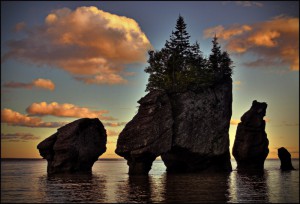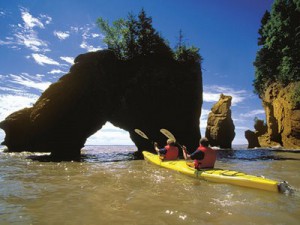
Carved from Fundy’s sandstone sea cliffs over the course of years and years, the Flower Pot Rocks – otherwise referred to as sea stacks – showcase the vertical variance of the Bay’s great tides.
Nicknamed the Flower Pot Rocks as the trees that grow at the top of the brown stacks resemble plants growing in a clay pot, sea stacks are found in a few places along Fundy’s coastline, but are most famous in Albert County, New Brunswick at Hopewell Cape.
Open from late-May until mid-October, visitors to the Hopewell Rocks can walk on the ocean floor at the base of these giant formations three hours before and after low tide. As the tides schedule changes daily, it is very important to check the tides in advance of your visit. At Hopewell Cape, high tide can be anyway from 32 to 46 feet (The Hopewell Rocks, 2011).

While not at all accessible during high tide, visitors to the site can walk the woodland trails, learn about the history and geology of the area in the interpretive centre, grab a snack at one of two cafés or peruse the gift shop for interesting trinkets. One of the most popular high tide activities at Hopewell, however, is kayaking.
Set out on a guided sea kayaking excursion on the Bay of Fundy and paddle in and around the sea stacks. Only 90 minutes to two hours in duration, this is a very unique adventure and provides a completely different perspective of the Rocks. Upon returning to the site at low tide to walk at the base of the Rocks, it is truly amazing to look up and realise that only a few short hours earlier you were paddling forty feet above your head!
In an earlier article, we wrote about Mi’kmaq legends concerning the Bay and the tides. According to The Hopewell Rocks website (2011), in ancient times Mi’kmaq people were slaves of angry whales who resided in the Bay. One day some of the slaves tried to escape but only made it as far the beach before being turned to stone by their whale captors. It is said that today they remain encased in these rock formations.
If you enjoyed this 24th article in our “52 Reasons to visit the Bay of Fundy” series then we recommend you check out the overview of all the articles in this series. You might also want to use our RSS feed so you won’t miss any articles in the future!
Jill Pitylak
That looks awesome. I need another trip William
Jonte
I was there and was amazed l
urmom
what are they
like…….a flowerpot rock is…
Wendy
can you please tell me how high the flower pots are?
Toep
higher than snoop
Ainey
😂